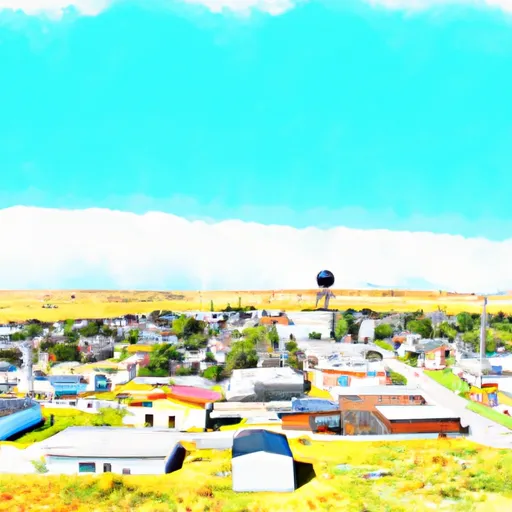-
 Snoflo Premium
Snoflo Premium
Get unlimited access to all our content
With no Ad interruptions! - Start Your Free Trial Login with existing account
Wyarno
Eden Index
Climate
7.4
•
Recreation
•
Community
•
Safeguard
3.0/10

Wyarno is a small unincorporated community located in Sheridan County, Wyoming. This area experiences a semi-arid climate with cold winters and mild summers. Winter temperatures can drop below freezing, while summer temperatures average around 80°F (27°C). Precipitation is relatively low, with an average annual rainfall of 15 inches (38 cm) and snowfall of 60 inches (152 cm).
The hydrology of Wyarno is predominantly influenced by the Powder River, which flows nearby. The river provides water for irrigation and supports diverse wildlife. Visitors can enjoy fishing and boating activities on the river, as well as observing the abundant bird species that inhabit the area.
Outdoor recreation opportunities in Wyarno are plentiful. Nearby mountains and forests offer opportunities for hiking, camping, and wildlife viewing. The Bighorn National Forest, located to the west, provides ample trails for hiking, mountain biking, and horseback riding. The region is also known for its excellent hunting opportunities, with big game such as elk and deer.
In summary, Wyarno, Wyoming offers a semi-arid climate, a hydrology influenced by the Powder River, and a variety of outdoor recreation opportunities centered around its natural beauty and proximity to the Bighorn National Forest.
What is the Eden Index?
The Snoflo Eden Index serves as a comprehensive rating system for regions, evaluating their desirability through a holistic assessment of climate health, outdoor recreation opportunities, and natural disaster risk, acknowledging the profound impact of these factors on livability and well-being.
Climate Health Indicator (CHI): 7.4
Wyarno receives approximately
385mm of rain per year,
with humidity levels near 69%
and air temperatures averaging around
8°C.
Wyarno has a plant hardyness factor of
4, meaning
plants and agriculture in this region thrive during a short period during spring and early summer. Most
plants will die off during the colder winter months.
By considering the ideal temperature range, reliable water supplies, clean air, and stable seasonal rain or snowpacks, the Climate Health Indicator (CHI) underscores the significance of a healthy climate as the foundation for quality living.
A healthy climate is paramount for ensuring a high quality of life and livability in a region, fostering both physical well-being and environmental harmony. This can be characterized by ideal temperatures, reliable access to water supplies, clean air, and consistent seasonal rain or snowpacks.
Weather Forecast
Streamflow Conditions
Tongue
Area Rivers
Tongue
Snowpack Depths
Tongue
Reservoir Storage Capacity
Tongue
Groundwater Levels
Recreational Opportunity Index (ROI):
The Recreational Opportunity Index (ROI) recognizes the value of outdoor recreational options, such as parks, hiking trails, camping sites, and fishing spots, while acknowledging that climate plays a pivotal role in ensuring the comfort and consistency of these experiences.
Access to outdoor recreational opportunities, encompassing activities such as parks, hiking, camping, and fishing, is crucial for overall well-being, and the climate plays a pivotal role in enabling and enhancing these experiences, ensuring that individuals can engage in nature-based activities comfortably and consistently.
Camping Areas
| Campground | Campsites | Reservations | Toilets | Showers | Elevation |
|---|---|---|---|---|---|
| Tongue River Reservoir State Park | 105 | 3,458 ft |
Nearby Fishing
Nearby Ski Areas
Catastrophe Safeguard Index (CSI):
The Catastrophe Safeguard Index (CSI) recognizes that natural disaster risk, encompassing floods, fires, hurricanes, and tornadoes, can drastically affect safety and the overall appeal of an area.
The level of natural disaster risk in a region significantly affects safety and the overall livability, with climate change amplifying these risks by potentially increasing the frequency and intensity of events like floods, fires, hurricanes, and tornadoes, thereby posing substantial challenges to community resilience and well-being.
Community Resilience Indicator (CRI):
The Community Resilience Indicator (CRI) recognizes that education, healthcare, and socioeconomics are crucial to the well-being of a region. The CRI acknowledges the profound impact of these elements on residents' overall quality of life. By evaluating educational resources, healthcare accessibility, and economic inclusivity, the index captures the essential aspects that contribute to a thriving community, fostering resident satisfaction, equity, and social cohesion.

